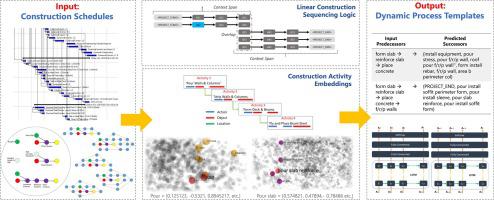Advanced Engineering Informatics ( IF 8.0 ) Pub Date : 2020-12-09 , DOI: 10.1016/j.aei.2020.101198 Fouad Amer , Mani Golparvar-Fard

|
Today, construction planning and scheduling is almost always performed manually, by experienced practitioners. The knowledge of those individuals is materialized, maintained, and propagated through master schedules and look-ahead plans. While historical project schedules are available, manually mining their embedded knowledge to create generic work templates for future projects or revising look-ahead schedules is very difficult, time-consuming and error-prone. The rigid work templates from prior research are also not scalable to cover the inter and intra-class variability in historical schedule activities. This paper aims at fulfilling these needs via a new method to automatically learn construction knowledge from historical project planning and scheduling records and digitize such knowledge in a flexible and generalizable data schema. Specifically, we present Dynamic Process Templates (DPTs) based on a novel vector representation for construction activities where the sequencing knowledge is modeled with generative Long Short-Term Memory Recurrent Neural Networks (LSTM-RNNs). Our machine learning models are exhaustively tested and validated on a diverse dataset of 32 schedules obtained from real-world projects. The experimental results show our method is capable of learning planning and sequencing knowledge at high accuracy across different projects. The benefits for automated project planning and scheduling, schedule quality control, and automated generation of project look-aheads are discussed in detail.
中文翻译:

通过顺序机器学习从现有的调度记录中为动态施工工作模板建模
如今,施工计划和进度安排几乎总是由经验丰富的从业人员手动执行。这些人的知识通过主计划表和预见计划得以实现,维护和传播。尽管可以使用历史项目进度表,但是手动挖掘其嵌入的知识以为将来的项目创建通用工作模板或修改预见进度表非常困难,耗时且容易出错。先前研究的严格工作模板也无法扩展以覆盖历史计划活动中的类间和类内可变性。本文旨在通过一种新方法来满足这些需求,该新方法可以从历史项目计划和进度记录中自动学习建筑知识,并以灵活且可通用的数据模式将这些知识数字化。具体来说,我们基于建筑活动的新型矢量表示形式提供动态过程模板(DPT),其中使用生成的长短期记忆递归神经网络(LSTM-RNN)对测序知识进行建模。我们的机器学习模型已在从实际项目中获得的32个时间表的多样化数据集上进行了详尽的测试和验证。实验结果表明,我们的方法能够跨不同项目高精度地学习计划和排序知识。详细讨论了自动化项目计划和计划,进度质量控制以及自动生成项目前瞻的好处。我们基于建筑活动的新型矢量表示形式提供了动态过程模板(DPT),其中利用生成的长期短期记忆递归神经网络(LSTM-RNN)对测序知识进行建模。我们的机器学习模型已在从实际项目中获得的32个时间表的多样化数据集上进行了详尽的测试和验证。实验结果表明,我们的方法能够跨不同项目高精度地学习计划和排序知识。详细讨论了自动化项目计划和计划,进度质量控制以及自动生成项目前瞻的好处。我们基于建筑活动的新型矢量表示形式提供了动态过程模板(DPT),其中利用生成的长期短期记忆递归神经网络(LSTM-RNN)对测序知识进行建模。我们的机器学习模型已在从实际项目中获得的32个时间表的多样化数据集上进行了详尽的测试和验证。实验结果表明,我们的方法能够跨不同项目高精度地学习计划和排序知识。详细讨论了自动化项目计划和计划,进度质量控制以及自动生成项目前瞻的好处。我们的机器学习模型已在从实际项目中获得的32个时间表的多样化数据集上进行了详尽的测试和验证。实验结果表明,我们的方法能够跨不同项目高精度地学习计划和排序知识。详细讨论了自动化项目计划和计划,进度质量控制以及自动生成项目前瞻的好处。我们的机器学习模型已在从实际项目中获得的32个时间表的多样化数据集上进行了详尽的测试和验证。实验结果表明,我们的方法能够跨不同项目高精度地学习计划和排序知识。详细讨论了自动化项目计划和计划,进度质量控制以及自动生成项目前瞻的好处。











































 京公网安备 11010802027423号
京公网安备 11010802027423号